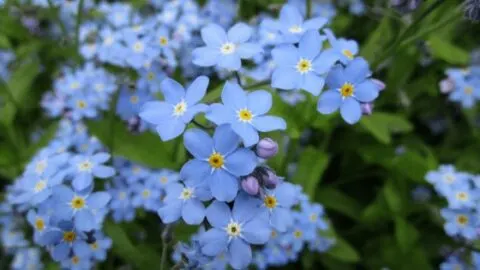You are looking into Forget-Me-Not Plant Care. My extensive care guide will cover all relevant details, from soil to watering and fertilizer.
Forget-Me-Not Plant Care Takeaways
Forget-me-nots prefer well-draining soil and must be watered every 3-7 days. These plants thrive in bright indirect light and enjoy a temperature range of 55-75°F (13-24°C). Humidity levels should be maintained between 40-60%. Fertilize twice a month and propagate through division or seeds.
| Field | Value |
|---|---|
| Species | Myosotis sylvatica |
| Synonyms | Forget-me-not |
| Family | Boraginaceae |
| Genus | Myosotis |
| Growth | Compact, spreading |
| Height | 0.0ft / 0.0m |
| Width | 1.0ft / 0.3m |
| Soil | Well-draining |
| Watering | Water every 3-7 days |
| Light | Bright indirect |
| Temperature | 55.0 – 75.0°F / 12.8 – 23.9°C |
| Humidity | 40.0 – 60.0% |
| Fertilizer | 2 times a month |
| Propogation | Division or seeds |
| Toxicity | No toxicity reported |
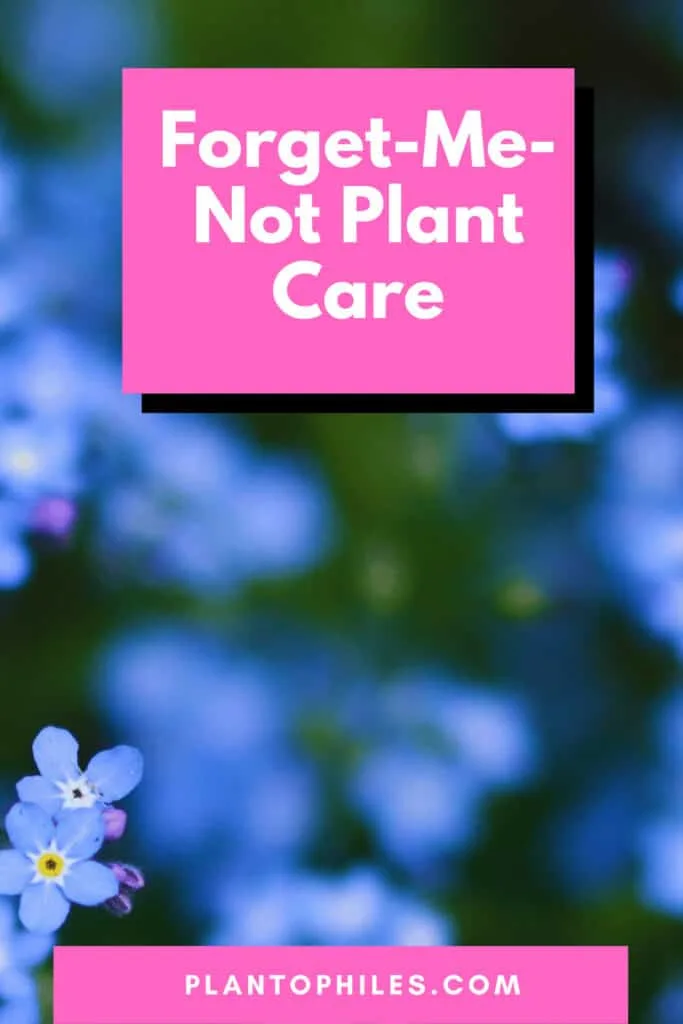
Forget-Me-Not Plant
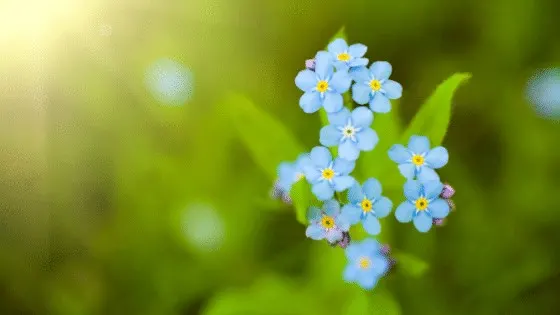
Forget-me-not, or Latin Myosotis sylvatica, is associated with a sign of never-ending love in the language of flowers. This powder blue flower has five petals that marry a yellow center.
These flowers bloom in spring and are only 0.4 inches in diameter (1 centimeter), making them one of the tiniest flowers. Forget-Me-Nots are extremely popular in-home gardens, adding a charming touch to the overall beauty.
Flower lobes also come in pink, white, and yellow centers, but the powder blue ones are recognized as the most common variation. They also qualify as an excellent indoor container plant.
After growing forget-me-nots, their care routine is the next crucial part. In this article, we will explore the caring instructions of this tiny plant to help you maintain its foliage clusters throughout summer and spring.
Table of Contents
Forget-Me-Not Growing Guide
Soil Requirements
Understanding the soil conditions these dainty flowers require is a primary step in their care. Forget-me-nots love soil that is both moist and fertile.
You must never allow the soil to drain and get dry, as this will deprive the flower growth of essential nutrients.
Plant them in soil with plenty of organic matter and a pH between 5.5 and 7. Prepare the soil by mixing in compost, cow manure, or peat moss before placing the flower seeds for growing.
Please note that the healthiest plants will come from seeds that are planted in well-worked soil. And not to forget that the soil must contain plenty of compost and has a great drainage quality.
Location
Forget-me-not needs well-drained soil with a semi-shaded location. Therefore, when it comes to picking a location, prioritize one that has partial shade.
If not, ensure it is protected against the hottest rays when the sun is at its peak. Direct sunlight will damage these delicate blue flowers instantly, wilting their growth.
If you live in a region that experiences hot summers, plant forget-me-not, where it only gets direct sunlight during early morning hours and shade for the rest of the day.
This location allows for the much-needed shade while allowing moisture retention, promoting optimal growth of this wildflower.
Even if you have an area of the shady pond, forget-me-nots will also love to grow there. You can also try planting the seeds indoors three weeks before the last expected frost.
Fertilizing
Using a slow-release nitrogen fertilizer, it is important to fertilize forget-me-nots at least once a year.
You can use 2-3 pounds approximately for every 100 square feet. Sprinkle the fertilizer over the soil and then water after a while.
Watering will allow the essential nutrients to dissolve and penetrate across the plantation. Read the package instructions carefully before fertilizing the soil.
You can use 10-5-5 fertilizer on every 50 square feet and a 10-10-10 fertilizer on every 100 square feet.
Watering
The forget-me-not plantation needs deep watering when 3 inches of soil feels dry (7.5 cm). Do not allow the plants to stand in water as this will cause the soil to get very damp.
Water the forget-me-nots often enough that the soil stays moist but not extensively soggy. During winters, water them only slightly.
As soon as winter hits, alter your watering routine to only twice a month while the plants are observed to be dormant.
In spring, you can resume your normal watering schedule. You can water using a drip irrigation system or a hose as this will ease the watering process.
Pruning and Deadheading
Forget-me-nots produce more flowers over a long growing season if you practice light pruning and deadheading.
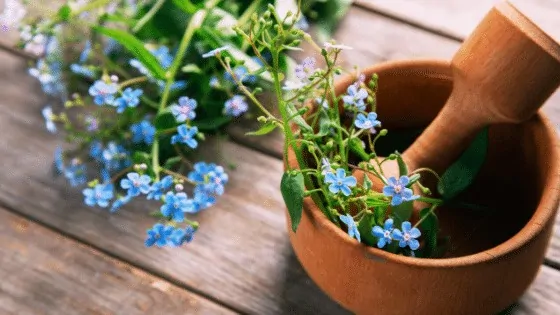
Pruning
- Snip off spent blossoms using scissors. This will encourage the plant to bloom more while discouraging reseeding and spreading. Make sure to cut flower stems back to the branch they are growing in. You can rub your scissors with alcohol before and after the trimming procedure to avoid spreading any diseases.
- Cutting entire branches, including the flowers, will give you cut flowers for indoor use.
- Make sure to prune each bush while shaping it neatly. This will help keep the form tidy and complete. Gardeners often prefer forming the forget-me-not plant into a spherical shape like a globe. It helps produce more flowering tips while giving the flowers a more attractive look.
- You must return the plant to the ground in late fall or early winter. The occasional perennial nature of this plant will send up new growth from the root system.
Deadheading Forget-Me-Nots
- It is important to remove wilted flowers regularly. This practice is referred to as deadheading in gardening terms. Flowers are observed to last only a few days; therefore, deadheading the forget-me-not plant twice a week is a best-suited practice.
- As soon as all the flowers and leaves wilt away, you can focus on removing the airborne portions of the plant. These parts of the plant look ungainly with their dead outlook. A timely removal will allow space for new and more fresh-looking flowers. They lend your garden a beautiful hint of blue surprise.
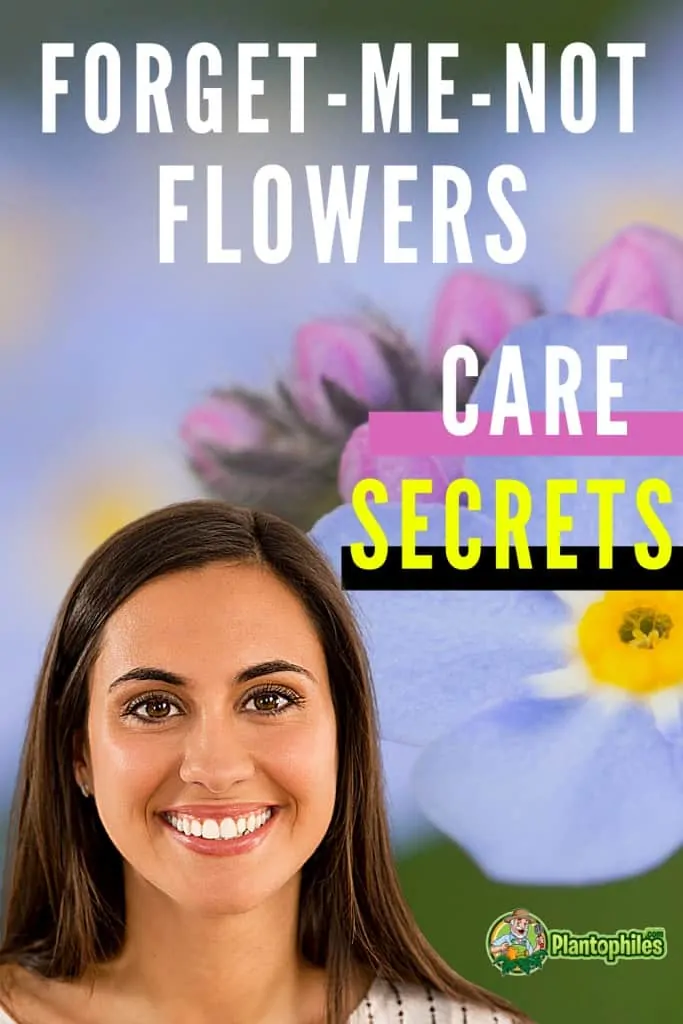
Forget-me-Not Flowers Pest And Diseases
A fresh arrangement of forget-me-nots is an eye-pleasing sight. But to get this picture-perfect plantation, it requires a sound understanding of the common problems that prevail in forget-me-nots. From pest attacks to fungal diseases, these delicate flowers are susceptible to several problems.
Once they are established in the landscape, forget-me-nots tend to develop a tough outlook, but this does not guarantee it to be a problem-free plant. However, luckily, most pests and diseases found in them are easily controllable.
Aphids
Aphids are tiny, soft-bodied insects like bugs that find their way easily to a garden. If not controlled on time, these sapsuckers multiply quickly and cause a serious problem for forget-me-nots.
Therefore, the sooner you catch them, the better. Inspect your plantation regularly to check for these tiny potato-like bugs. Watch out for ants that farm on aphids as they quickly re-establish their colony.
The presence of aphids in plants is a clear indication of distorted flower formation. It also results in virus transmission from plant to plant. Aphids can be controlled using cold water sprays.
You can also mix cayenne pepper and soap over the infected plants. A regular spray of pepper or soapy water can control aphids adequately. You can also remove them by hand.
Crown Rot
Crown rot falls under the same category of nasty plant diseases such as root rot, which adversely affects plant growth—caused by a fungus. This garden malady developed in soil with heavy rainfalls and flash floods over time. Among other reasons for formation is a lot of water standing at one location.
This disease is comparatively difficult to notice, and once it does the damage, the plant cannot be brought back to life by any means. Therefore, diagnosing it early and preventing its spread is the only solution.
It is a clear sign of a crown rot attack if you notice wilting on your plants with cobweb threads at the base.
This fundal pathogen eats away any forget-me-not it comes across with. As the disease continues to spread, the plant will die. Eventually, the leaves will sometimes turn yellow, purple, or even red. The plant growth will also become stunted.
As soon as you catch the first signs of crown rot, prepare yourself up to take immediate action for pest control. First, identify all infected parts of the plantation and pull them out.
And later discard them to prevent the outbreak from affecting other parts of the garden.
You should also clean the tools to control the spread so that spores that lead to crown rot development don’t spread.
Be sure to sanitize the area and amend the soil in the infected area so that the crown rot does not develop again.
Replace the infected soil or destroy it immediately. To amend the soil, work in a generous amount of rich soil so that it helps even out the clay proportion of the soil.
Powdery Mildew
Powdery Mildew is identified as a fungal disease, making it a serious threat to the well-being of forget-me-nots. It affects all parts of the flower plantation without any discrimination.
This fungus is favored by high humidity conditions that produce dry leaves. Initially, a white powdery layer settles in on the foliage, which is the first alarming sign that your plants are now being infected with this fungal disease.
A major part of the fungus persistently settles on the outer parts of the plant. And it eventually sinks to the root system, competing with the plant cells for essential nutrients.
This clearly explains the undernourished, wilted flower production.
Powdery Mildew can be controlled by removing infected plants.
You must later dispose of all the infected plants carefully so that other parts of the garden do not get infected. This measure helps the other plantation to grow in a nourished condition.
Spraying the infected plants with organic fungicides is also recommended for faster recovery. You must also space the plants at a good distance to allow for healthy air circulation.
Try your best to avoid overhead watering procedures if your plants have powdery Mildew.
Aster Yellows
Aster yellow is a systematic chronic disease spread by leafhoppers. Leafhoppers spread phytoplasma over the plants as they feed on them individually.
Infect forget-me-nots then turn yellow and wilt, sporting a stunted growth. The spread of aster yellow accelerates when the weather is cool and eventually worsens in wet summers.
Remove the infected parts of the plant immediately to control the spread of this incurable disease.
A wise and early diagnosis with prompt action is recommended to prevent aster yellow from affecting the entire garden.
Although the disease is not considered fatal for the entire plantation, any prevailing signs make it impossible for the forget-me-nots to produce healthy flowers.
Since leafhoppers are known to hide in weeds, weeding the surrounding area is also recommended to prevent any potential aster-yellow attacks in the future.
FAQ
How often should I fertilize my soil when it is planted with forget-me-not seeds?
The fertilization routine for forget-me-nots significantly depends on the nutrients in your soil. Generally, forget-me-nots require fertilization at least twice a year.
Once in spring, when they are planted, and then in the fall, most gardeners describe early fall as the ideal time for the second fertilization cycle.
This allows the soil to boost towards the end of the season while preparing the plants to grow strong in the following spring. You can also spread a 2- to 3-inch layer (5.0 – 7.5 cm) of organic mulch over the soil to help keep it moist. Water the plants when the top of the soil begins to dry.
Can forget-me-nots be used as complementary planting?
Forget-me-not is classified as a low-growing ground cover. With a six to eight-inch size, they tend to spread widely, thus making it a good complementary plant.
For a garden with tall woodlands and sun perennials like ferns and irises, forget-me-nots make a great companion.
They not only facilitate softening the base of these plants but also elevate the overall look with their beautiful, eye-pleasing color.
Are forget-me-nots easy to grow?
When it comes to growing forget-me-nots, it is relatively easy. They are mostly grown as an annual by starting seeds in pots indoors. As long as you provide nutrient-dense soil that is organically rich in all essential elements the plant needs for growth, it will grow easily without causing trouble.
You must also manage the watering routine and provide a shaded area for better growth. However, if they are out of their comfort zone, they may cause some fuss during the growing period.
Why are my forget-me-nots not blooming?
If your forget-me-nots are not blooming, then there are three primary reasons contributing to the cause,
- Too much sunlight – as mentioned earlier, forget-me-nots grow in partially shaded areas, exposure to excessive sunlight translates directly into limited success with flowers. Instead of producing flowers, the plants will burn or wilting under the hot sun.
- Improper fertilization – the soil needs to be fertilized to work in the essential nutrients. But too much of something can make things worse. Similarly, if you overwork soil fertilizers, forget-me-nots won’t bloom. So carefully schedule your fertilization routine to twice a year.
- Dry soil – forget-me-not loves bog; thus, super moist soil is what we are looking for. Ensure to keep the moisture levels up by watering during hot, humid conditions when there is not enough rain. Dry soil will majorly contribute to a plan that does not have five flowers.
The Last Forget-Me-Not
When naming a class woodland garden plant, forget-me-not takes the crown. This charming plant aesthetically forms a carpet in the garden with its blue arrangement of flowers.
With minimal effort, you get a delicate bed of blooming flowers in the garden that complements all types of flowers and foliage.
Forget-me-nots are a memorable, iconic plant that sticks on your clothes and signals you not to forget them anywhere you go. With low-maintenance quality and easy care, these powder flowers also come in white and pink colors, making them a perfect pick for any garden.

Daniel has been a plant enthusiast for over 20 years. He owns hundreds of houseplants and prepares for the chili growing seasons yearly with great anticipation. His favorite plants are plant species in the Araceae family, such as Monstera, Philodendron, and Anthurium. He also loves gardening and is growing hot peppers, tomatoes, and many more vegetables.

